Papermate PhD Multi Pen Review
Regular readers of this blog will be aware that I recently had a little overseas holiday. In the past I have often
taken mini pencils as part of my travel kit but this time around I thought to myself that surely international travel was one of those occasions when one should consider a multi pen. So I swept aside the usual contenders and grabbed the Papermate PhD Multi that was lurking around in my office.
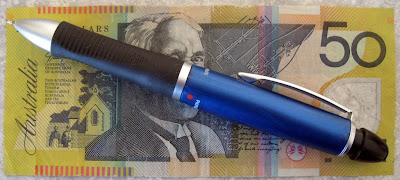
The Papermate PhD Multi has three tips to select from, and a quick bit of web-time lead me to the conclusion that Papermate offer the PhD Multi in two formats. The first format is ballpoint pen, mechanical pencil and stylus. This is the only format mentioned on the Papermate website. However, there is a second readily available format, namely two ballpoint pen tips and a mechanical pencil tip. The ballpoint pen colours available are black and red, but 0.5mm seems to be only the mechanical pencil option. My PhD is this second version – two pens and a pencil.
Being a fairly substantial size, and a multi pen, the PhD Multi is a heavier than your average mechanical pencil, and a little top heavy in the hand.
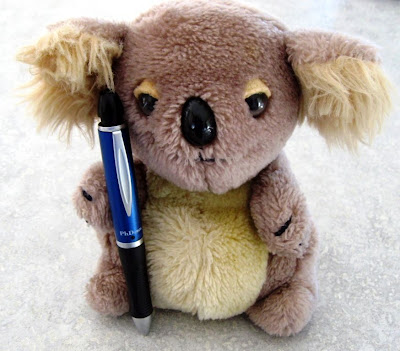
The grip zone of the PhD Multi is a fairly deeply scalloped grooved rubber triangular grip. It’s a fairly large sized grip, the sides of the triangle are about 12mm long. The rubber compound is reasonably hard but quite ‘grippy’. Now, I’ve had plenty of bad thoughts about rubber grips over the years but this is a rubber grip that unquestionably improves things. The rubber compound, the grooves and the contoured shape all combine to provide an extremely positive and secure grip. I note that the Papermate website states the grip is “endorsed by the American Physical Theraphy Association.”
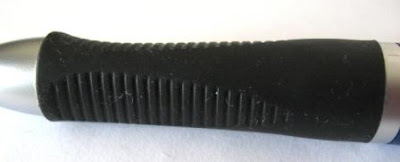
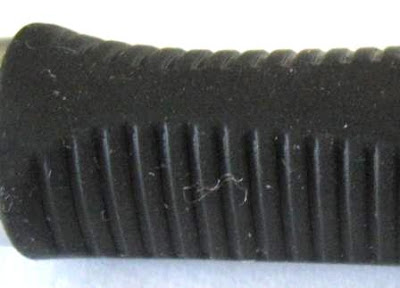
One thing I do not usually cover in my reviews is the long-term reliability and durability of a writing instrument. That’s because I’m usually only using the review item for a week or two, and taking good care of it, so that I can put it back into my collection in “as new” condition. So, long term durability is beyond the scope of my reviews. The rubber grip on the PhD Multi just felt a little thin to me and the triangular grip would tend to concentrate the wear pattern, which made me think about long term durability, so I took the unusual step of doing a bit of searching for feedback on shopping sites, etc. I wasn’t too surprised to find a number of commenter’s stating that the rubber grip stretched or loosened and came off over time. Peoples expectations of durability and life-expectancy are very subjective and highly variable, but there might be a bit of an issue with the rubber grip. But hey, I think there’s one problem or another with all rubber grips! Seriously though, no rubber grip is going to last as long as bare metal or a section of hard moulded plastic body, and I imagine the softer and squishier your rubber grip, the more prone it is to wear and tear. Everything’s a compromise; it’s just something to keep in mind.
Right, let’s get back to writing with the PhD Multi. You select your desired tip by twisting the top half of the body to the left or right. This is not a continuous twist mechanism; in other words you cannot just go round and round. When you have reached the far left position you must then twist back to the centre position and on to the right position, and then back again, etc. Coloured dots and a pencil tip logo indicate which tip is where. You twist to line up the desired tip indicator with the small depression in the silver centre ring. This depression is quite small and not particularly conspicuous, so you might need a second glance to locate it.

The ballpoint pen tips write very well, with a nice smooth ink flow. They really do glide across the paper. The black ink appears good and black, and the red is a proper red.
When the mechanical pencil tip is extended it is a short cylindrical lead sleeve leading into a cone. Of course the very nature of this type of multi pen mechanism means the writing tip extends out of the front section at a slight angle.
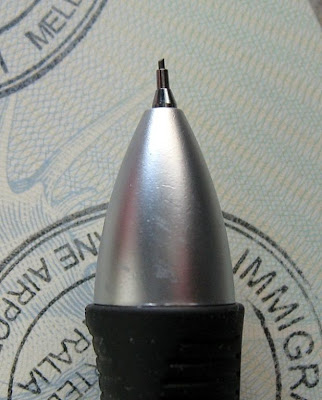
Remember the writing tip is on a long stalk which is just bent and thrust out of the front section when it is selected. I mention this because somehow this is the first multi pen that I have really noticed the axis of the mechanical pencil is not aligned with that of the pen body. You can see it is protruding out at an angle. This is normal with many multi pens, it’s just I don’t normally notice it, but somehow with the PhD Multi I did.
The mechanical pencil is 0.5mm lead diameter and operates as a push top button ratchet mechanism. Ten clicks will get you about 6mm of lead. For a multi pen the push top action is quite light, easy and smooth, although it has a fairly long stroke on it as is common with multi pens. I often find that multi pen pencil tips are prone to more lead breakages than normal, but I didn’t notice that with the PhD.
Refilling the pencil tip or replacing the ballpoint pen tips is done in the usual way. You carry on twisting past the end stop to unscrew the body and reveal the three tips, rip the empty tip out of its mounting and replace or refill. You can really only get one or two spare leads into the pencil stalk, and take care not to snap them when putting the pencil tip back onto it’s stalk.

Beneath the push top button is a medium sized eraser.
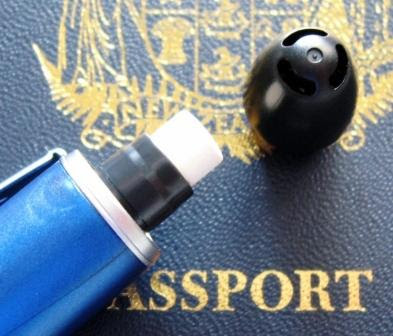
The top button clicks on fairly firmly and securely. The pocket clip is a basic sturdy springy metal clip and it joins on at the very top of the body..
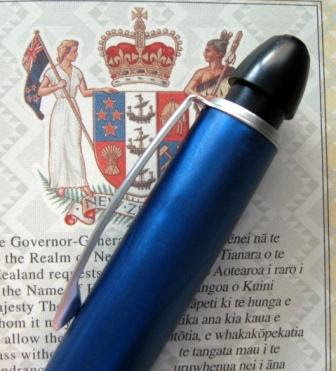
I tended to carry my PhD Multi clipped to the centre of a small wallet-folder which held our passports and other travel documents.
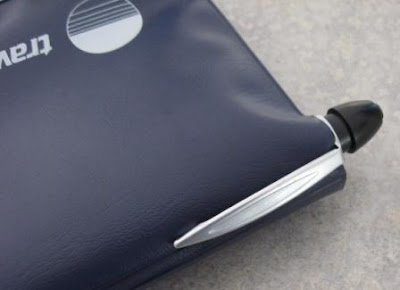
Now, because there is no part of the main body above the top of the pocket clip this means that the top button is the first thing you go to grab when you want the pen, and of course the top button just pulls off the body leaving the pen still clipped to whatever. This is hardly an earth shattering disaster, but it was a little annoying each time it caught me out, maybe because it reminded me I was being a slow learner. I’ve got my doubts about how long that top button would last before it was lost, or no longer stayed securely stuck on
Markings on the pen are "PhD Multi" and "Papermate, Japan" on the barrel.
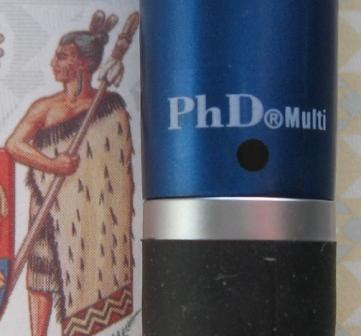
Overall then, I’m reasonably impressed with the Papermate PhD Multi, and as a concept I think multi pens might be the way to go when travelling. Black ballpoint for filling out customs and immigration documents, pencil for a quick sketch and the crossword, red pen for a highlight – all came in handy at one stage or another.
- Best Points – The grip.
- Not So Good Points – Eraser cap can pull off when pen is clipped to papers.
- Price Range – Low.
- Does this pencil make it into the Top 5? - No.
Dimensions – Length 150mm, diameter 15mm at widest point. Balance point about 75mm up from the tip.
“Holiday Apartment”
Real Life

And Still Life?


 Or you can pull it out of the body…
Or you can pull it out of the body… Looks rather smart with that lined pattern. Quite classy really. I don’t know the correct name for that pattern – perhaps light godron? The eraser is unused but rather old and hardened, and stuck tight in the body. Anyway, the pencil is a tip feed as you would expect from an older 1.18mm screw mechanism mechanical pencil.
Looks rather smart with that lined pattern. Quite classy really. I don’t know the correct name for that pattern – perhaps light godron? The eraser is unused but rather old and hardened, and stuck tight in the body. Anyway, the pencil is a tip feed as you would expect from an older 1.18mm screw mechanism mechanical pencil.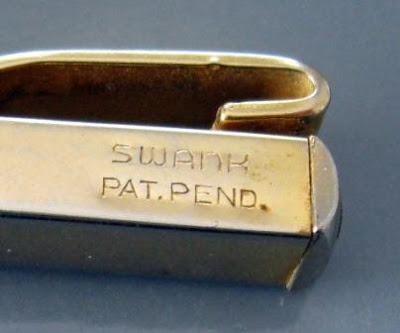 So, a quick bit of internet searching, and now I’m just blithely repeating internet information here, so it could well be rubbish, but apparently Swank is a US jewellery company founded in Massachusetts in 1897. Originally they manufactured and distributed men's and women's costume jewellery and during World War I they made dog tags for the US military. After WWI they changed focus to produce only men's jewellery and accessories. They are still going today, and apparently their products are common in US department stores. (OK, don’t leave me hanging here, nip out to your local mall and confirm or deny this.)
So, a quick bit of internet searching, and now I’m just blithely repeating internet information here, so it could well be rubbish, but apparently Swank is a US jewellery company founded in Massachusetts in 1897. Originally they manufactured and distributed men's and women's costume jewellery and during World War I they made dog tags for the US military. After WWI they changed focus to produce only men's jewellery and accessories. They are still going today, and apparently their products are common in US department stores. (OK, don’t leave me hanging here, nip out to your local mall and confirm or deny this.)


 Others say it’s a mechanical pencil money-clip.
Others say it’s a mechanical pencil money-clip.
 Ha! I hope at least some of you appreciate that I had to dig my ties out of storage, and go to the bank especially for those shots - I don’t normally carry any Rutherfords in my wallet. Some unkind people have suggested moths are more likely in my wallet. How rude! The cheek of them! In case you haven’t noticed, most photos in this posting are clickable for hi-res. Yep, revel in the sartorial elegance of those ties.
Ha! I hope at least some of you appreciate that I had to dig my ties out of storage, and go to the bank especially for those shots - I don’t normally carry any Rutherfords in my wallet. Some unkind people have suggested moths are more likely in my wallet. How rude! The cheek of them! In case you haven’t noticed, most photos in this posting are clickable for hi-res. Yep, revel in the sartorial elegance of those ties.















 I envisage that the target market for this was the gentleman-gamer from the first half of the 20th century.
I envisage that the target market for this was the gentleman-gamer from the first half of the 20th century. Nail file and cleaner tip, about 4cm long
Nail file and cleaner tip, about 4cm long  Entertainment, each about a 1/2cm cube.
Entertainment, each about a 1/2cm cube. 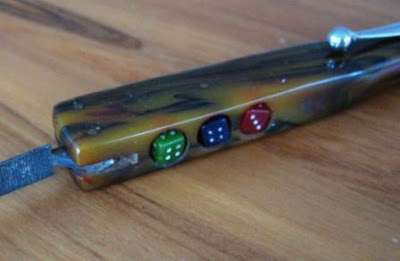
 There are no markings anywhere except on the base of the pen-knife blade. On one side is “Made in Germany” and on the other is “Palmax, D.R.G.M., Solingen”. So we know it was made in Solingen, the heart of the German knife and cutlery industry. I believe Palmax is the brand, and apparently DRGM stands for "Deutsches Reichsgebrauchsmuster" which means "Utility patent of the 'Deutsches Reich'" and was a German patent and business protection mark from 1891 to WWII.
There are no markings anywhere except on the base of the pen-knife blade. On one side is “Made in Germany” and on the other is “Palmax, D.R.G.M., Solingen”. So we know it was made in Solingen, the heart of the German knife and cutlery industry. I believe Palmax is the brand, and apparently DRGM stands for "Deutsches Reichsgebrauchsmuster" which means "Utility patent of the 'Deutsches Reich'" and was a German patent and business protection mark from 1891 to WWII.

 Luckily pencil lead isn’t that tough so you can usually easily chip away at and dig out the old stuck piece of lead with a pin or needle. The 1mm drill comes in handy if you have to go digging deep as you can usually drill and crumble the lead out from way inside the mechanism. In the photo you can see a decent chunk of old lead that I dug out of the gripper. I initially assumed this would be a 1.18mm pencil, but a I had a stick of 1.4mm lead handy and it fitted fine. It only takes short lengths of lead.
Luckily pencil lead isn’t that tough so you can usually easily chip away at and dig out the old stuck piece of lead with a pin or needle. The 1mm drill comes in handy if you have to go digging deep as you can usually drill and crumble the lead out from way inside the mechanism. In the photo you can see a decent chunk of old lead that I dug out of the gripper. I initially assumed this would be a 1.18mm pencil, but a I had a stick of 1.4mm lead handy and it fitted fine. It only takes short lengths of lead.
 At first I thought, hey, wow, some sort of lift out
At first I thought, hey, wow, some sort of lift out 

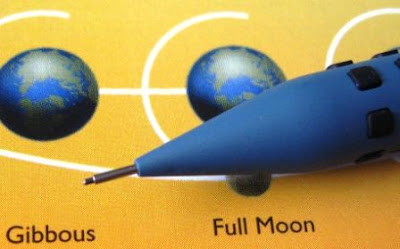 Up above the grip section is a lead hardness indicator. You unscrew the grip a fraction to allow the window to rotate and expose the appropriate lead grade – 2B to 4H, including F.
Up above the grip section is a lead hardness indicator. You unscrew the grip a fraction to allow the window to rotate and expose the appropriate lead grade – 2B to 4H, including F.  Up at the top end of the pencil is the push top button which has a concertina type shaft cover, another feature that I find visually appealing. Ten clicks of the mechanism will get you about 5mm of 0.5mm lead. This is on the shorter side of town, definitely allowing for precise dispensing of your lead. On the one hand I admire and like the precision of this lead advancement, but if you are using the Smash mechanical pencil to write with then you will probably be clicking away a lot more than usual.
Up at the top end of the pencil is the push top button which has a concertina type shaft cover, another feature that I find visually appealing. Ten clicks of the mechanism will get you about 5mm of 0.5mm lead. This is on the shorter side of town, definitely allowing for precise dispensing of your lead. On the one hand I admire and like the precision of this lead advancement, but if you are using the Smash mechanical pencil to write with then you will probably be clicking away a lot more than usual. 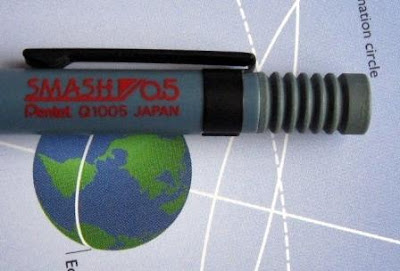 The pocket clip is a small plain matt black metal clip - firm and functional.
The pocket clip is a small plain matt black metal clip - firm and functional. “Smash 0.5 Pentel Q1005 Japan” is printed on the body up towards the top.
“Smash 0.5 Pentel Q1005 Japan” is printed on the body up towards the top. 
 Just for the record, the close up photos of the concertina push top button make it look a bit unappealing and do it a bit of a disservice - it looks better in real life.
Just for the record, the close up photos of the concertina push top button make it look a bit unappealing and do it a bit of a disservice - it looks better in real life.




